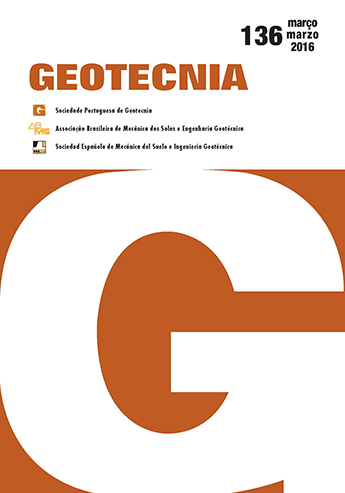Behavior of soil-bentonite and soil-cement-bentonite mixes for use in vertical cutoff walls
DOI:
https://doi.org/10.24849/j.geot.2016.136.06Keywords:
Triaxial tests, Barriers, Soil-Cement-Bentonite (SCB) mixtures, Hydraulic conductivityAbstract
Vertical cutoff walls are a quick and effective solution in solving geotechnical and environmental problems concerning containment of subsurface contamination. With the objective of studying the behaviour of materials suitable to use as a fill for these barriers, undrained triaxial tests (CIU) and hydraulic conductivity tests were carried out in soil-bentonite (SB) and soil-cement-bentonite (SCB) mixtures. Different water-cement ratios, water contents and confining pressures were analysed, as well as three different bentonite contents for SCB mixes and two for SB mixes. The global analysis of the results allowed identifying changes in mechanical behaviour and hydraulic conductivity due to parameter variation. The results of the CIU tests indicated that for the same bentonite content, decreasing the water/cement ratio resulted in an increase in material strength parameters. For a w/c ratio of six, increasing the bentonite content also caused an increase in material strength parameters. Results of hydraulic conductivity tests revealed that SCB mixes had higher hydraulic conductivity than SB mixes.
Downloads
References
Andromalos, K.B.; Fisher, M.J. (2001). Design and Control of Slurry Wall Backfill Mixes for Groundwater Containment. In: International Containment and Remediation Conference. Orlando. Disponível em: http://www.containment.fsu.edu/cd/content/pdf/041.pdf. Acesso em: 15 jan. 2004.
ASTM D 2487 (1993). Standard Classification of Soils for Engineering Purposes. American Society for Testing and Materials. Philadelphia. 11p.
Bellezza, I.; Pasqualini, E. (1997). Hydraulic performance of soil-cement liners. Proceedings of GeoEnvironment 97. Bouazza, Kadikara & Parker (Eds.). Balkema, Rotterdam. pp. 271-276.
Bishop, A.W.; Henkel, D.J. (1962). The measurement of soil properties in the triaxial test. London: Edward Arnold, 2nd ed., 277p.
Bouazza, A.; Manassero, M.; Smith, N. (1999). Cement-bentonite Slurry Walls for Waste Containment [online]. In: N.D. Vitharana e R. Colman (Eds.). Proceedings of 8th Australia New Zealand Conference on Geomechanics: Consolidating Knowledge. Barton, ACT: Australian Geomechanics Society, pp. 679-684.
Chew, S.H.; Kamruzzaman, A.H.M.; Lee, F.H. (2004). Physicochemical and engineering behavior of cement treated clays. ASCE Journal of Geotechnical and Geoenvironmental Engineering, 130(7), pp. 696-706.
Clayton, C.R.I.; Khatrush, S.A. (1986). A new device for measuring local axial strain on triaxial specimens. Géotechnique, London, v.25, n.4, pp. 657-670.
Clayton, C.R.I.; Khatrush, S.A.; Bica, A.V.D.; Siddique, A. (1989). The use of Hall effect semiconductor in geotechnical instrumentation. Geotechnical Testing Journal, v.12, n.1, pp. 69-76.
D’Appolonia, D.J. (1980). Soil-Bentonite Slurry Trench Cutoffs. Journal of the Geotechnical Engineering Division ASCE, v.107, no. 4, pp. 399-417.
Evans, J.C. (1994). Hydraulic conductivity of vertical cutoff walls. In: D.E. Daniel and S.J. Trautwein (Eds.). Hydraulic Conductivity and Waste Contaminant Transport in Soil. ASTM STP 1142, American Society for Testing and Materials, Philadelphia.
Evans, J.C. (1993). Vertical cutoff walls. In: D.E. Daniel (Ed.). Geotechnical Practice for Waste Disposal. London: Chapman & Hall. Ch. 17, pp. 430-454.
Gaucher, E.C.; Blanc, P. (2006). Cement/clay interactions – a review: experiments, natural analogues, and modeling. Waste Management, 26(7), pp. 776-788.
Head, K.H. (1980). Manual of Soil Laboratory Testing. Vol 2: Permeability, Shear Strength and Compressibility Tests. London: Pentech Press. 402p.
Heineck, K.S. (2002). Estudo do comportamento hidráulico e mecânico de materiais geotécnicos para barreiras horizontais impermeáveis. Tese de doutorado. PPGEC/UFRGS, Porto Alegre, Brasil. 251p.
Horpibulsuk, S.; Miura, N.; Nagaraj, T.S. (2005). Clay–water∕cement ratio identity for cement admixed soft clays. ASCE Journal of Geotechnical and Geoenvironmental Engineering, 131(2), pp. 187-192.
Jefferis, S. (2012). Cement-Bentonite Slurry Systems. In: LF. Johnsen et al. (Eds.), Grouting and Deep Mixing 2012, pp. 1-24. doi: 10.1061/9780784412350.0001.
LaGrega, M.D.; Buckingham, P.L.; Evans, J.C. (1994). Hazardous waste management. McGraw Hill, 1146 p.
Lorenzo, G.A.; Bergado, D.T. (2004). Fundamental parameters of cement admixed clay - new approach. ASCE Journal of Geotechnical and Geoenvironmental Engineering, 130(10), pp. 1042-1050.
NBR 6502 (1995). Rochas e solos. Associação Brasileira de Normas Técnicas (ABNT). Rio de Janeiro. 18p.
Opdike, S.M.; Evans, J.C. (2005). Slag-cement-bentonite slurry walls. Journal of Geotechnical and Geoenvironmental Engineering ASCE, v. 131, no. 6, pp. 673-681.
Pearlman, L. (1999). Subsurface Containment and Monitoring Systems: Barriers and Beyond. Disponível em: www.slurrywall.com/articles/4.pdf. Acesso: 10 dez. 2003.
Read, D.; Glasser, F.P.; Ayora, C.; Guardiola, M.T.; Sneyers, A. (2001). Mineralogical and microstructural changes accompanying the interaction of Boom Clay with ordinary Portland cement. Advances in Cement Research, 13(4), 175-183.
Ryan, C.; Spaulding, C. (2008). Strength and Permeability of a Deep Soil Bentonite Slurry Wall. GeoCongress 2008, pp. 644-651. doi: 10.1061/40970(309)81.
Skempton, A.W. (1954). The pore-pressure coefficients A and B. Géotechnique, London, v.4, pp. 143-147.
Xanthakos, P.P. (1979). Slurry Walls. New York: McGraw-Hill. 622p.




